
Revolutionary Discovery: Moon Had a Weak Magnetic Field 2 Billion Years Ago!
2025-01-06
Author: Yu
Revolutionary Discovery: Moon Had a Weak Magnetic Field 2 Billion Years Ago!
In a groundbreaking study that challenges our understanding of lunar history, researchers at the Chinese Academy of Sciences have revealed compelling evidence that the Moon possessed a weak magnetic field around 2 billion years ago. This significant finding, detailed in the latest edition of the journal *Science Advances*, emerged from the analysis of rock samples collected during China's impressive Chang'e-5 lunar mission.
In a related commentary in the same journal, Benjamin Weiss from MIT provided an overview of ongoing research about the Moon's magnetic field, highlighting how the new findings fit into the broader narrative of lunar studies.
The Chang'e-5 mission, which successfully returned to Earth in December 2020 with 1,731 grams of lunar dust and rock samples, has proven to be a treasure trove for scientific inquiry. Since then, various research teams have been scrambling to unlock the secrets held within these samples. The latest analysis focused on identifying the magnetic history of the Moon, which could redefine our understanding of its geological evolution.
Currently, the Moon lacks an overarching magnetic field, but scientists believe it once had one, attributed to thermomechanical convection in its interior leading to a dynamo effect. Previous investigations of lunar samples returned by the Apollo missions and Russia's Luna program provided evidence of a magnetic field approximately 4 billion years ago. However, this newly uncovered data not only extends the timeline of lunar magnetism but also suggests that the field was present long after the Moon's initial formation.
The samples tested by the Chang'e-5 mission, predominantly consisting of basalt, revealed a weak magnetic field intensity ranging from 2,000 to 4,000 nanoteslas approximately 2 billion years ago. This period represents a crucial phase in lunar history. Such a magnetic field would indicate the presence of molten material lingering beneath the lunar surface much longer than scientists had previously believed.
Moreover, the existence of a magnetic field might imply that the Moon experienced volcanic activity well into its later years, raising intriguing questions about its geological past. Evidence suggests that the Moon may have been hospitable to water, particularly in its shadowed regions, where a magnetic field could protect surface water from being stripped away by the solar wind, preserving it in liquid or frozen states.
These findings not only illuminate the Moon's mysterious geological history but could also have larger implications for our understanding of other celestial bodies with similar characteristics. Is the Moon more active and dynamic than we've ever thought? Stay tuned for more updates, as this discovery opens new doors to exploring the mysteries of our cosmic neighbor!

 Brasil (PT)
Brasil (PT)
 Canada (EN)
Canada (EN)
 Chile (ES)
Chile (ES)
 Česko (CS)
Česko (CS)
 대한민국 (KO)
대한민국 (KO)
 España (ES)
España (ES)
 France (FR)
France (FR)
 Hong Kong (EN)
Hong Kong (EN)
 Italia (IT)
Italia (IT)
 日本 (JA)
日本 (JA)
 Magyarország (HU)
Magyarország (HU)
 Norge (NO)
Norge (NO)
 Polska (PL)
Polska (PL)
 Schweiz (DE)
Schweiz (DE)
 Singapore (EN)
Singapore (EN)
 Sverige (SV)
Sverige (SV)
 Suomi (FI)
Suomi (FI)
 Türkiye (TR)
Türkiye (TR)
 الإمارات العربية المتحدة (AR)
الإمارات العربية المتحدة (AR)